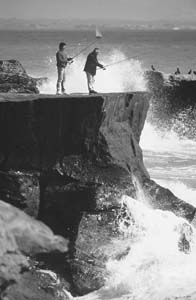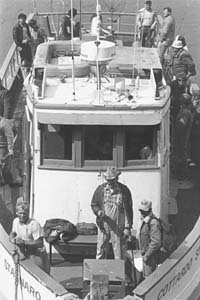Mercury Rising
Photo by Tony Hertz
As the EPA considers allowing more mercury contamination in state water, scientists warn of disease and poisoned salmon
By Sarah Phelan
'NOT ALL MERCURY is created equal," said Khalil Abu-Saba, a graduate geochemist at UC-Santa Cruz, as he demonstrated how mercury existing in subparts-per-billion in a stream can "bioaccumulate" in fish until it's become a human health hazard. Addressing a public hearing in November, Abu-Saba began by holding up a specimen of cinnabar, a reddish, steaklike slab of ore that local Indians used as a pigment for body paint until they discovered it caused severe skin irritation.
Cinnabar, Abu-Saba explained, is a form of mercury that was mined during the Gold Rush for the process of extracting gold from stream gravel and background rock. More than 65 percent of the quicksilver was spilled in that process, he said. That mercury, spilled a century ago, is still around.
Ever since miners swarmed to the frontier in the hope of hitting the mother lode, California has been called the Golden State. But scratch beneath the glitzy surface, from the Hollywood hills to Silicon Valley, and you'll find a darker, more troubled landscape--a haunting legacy of abandoned mercury mines.
Traces of that poisonous legacy can be found in fish caught off the Santa Cruz pier and, according to some environmental scientists, also in the people who eat those fish.
Mercury--the most toxic of all natural metals--was a key element in the Gold Rush. The freight wagons that rolled into camps back in 1847 didn't merely provide fortune-hungry miners with beef, beans and whiskey. They also supplied thousands of flasks of mercury to be used in the amalgamation process.
As the Gold Rush peaked, eager entrepreneurs built more than 100 mercury mines in California, unwittingly opening an environmental Pandora's box. When the federal government recognized the danger and prohibited mercury amalgamation of gold in the early 1970s, these same mines became unprofitable and were abandoned, often in close proximity to waterways, residential communities and recreational facilities.
Most of us are familiar with quicksilver, the highly mobile, elemental form of mercury which, given half a chance, will race off in little silvery balls. It was this mobility that led this metal to be named after Mercury, the fastest-moving planet in our solar system, which in turn was named for the winged-sandaled messenger of the Roman gods.
These days, mythological explanations have been abandoned in favor of science. Yet scientists are discovering that mercury can be as changeable and fast-moving as its namesake.
Mercury can travel long distances in the atmosphere. Even worse, once deposited in the soil, mercury can frenetically "grasshopper" from the soil to the air and water, in a style worthy of the fleet-footed messenger himself.
But the worst news is that once released into the environment, inorganic mercury can be converted by bacteria into highly toxic organic methylmercury--the stuff that "bioaccumulates."
The methylmercury, Abu-Saba says, is concentrated by plankton at the base of the food chain. When filter feeders consume these plankton, the mercury is further concentrated.
"The process repeats itself over and over in a complex food chain," he says, "with the result that mercury in predator fish ends up one million times higher than that in the surrounding water."
Consequently, eating substantial amounts of tuna or swordfish could leave you mad as a hatter.
Crazy Cats
AT A PUBLIC HEARING in San Francisco last November, activists and research scientists expressed discontent with an EPA proposal that would raise the acceptable level of mercury 60-fold in surface water and four-fold in drinking water. That move had resulted from a legal fight between the state and several "dischargers," including the cities of San Jose, Sunnyvale, Sacramento and Stockton. The cities won a lawsuit by arguing that the state had not sufficiently considered the economic costs of adopting its water protection laws.
The dischargers complain about the prohibitive costs of treating water in the Bay Area, even with higher levels of mercury allowed. Meanwhile, activists and scientists argue that while the EPA's new criteria might make economic sense, they are environmental madness.
Abu-Saba hasn't brought any organic mercury with him to the hearing because "it's too toxic to handle safely," he says. Instead, he's brought the obituary of Karen Wetterhahn, a prominent Dartmouth researcher who died last year from neurological damage just three months after she spilled two drops of dimethylmercury onto her latex gloves.
Wetterhahn is only the most recent victim of mercury poisoning. Lewis Carroll's manic Mad Hatter of Alice in Wonderland fame was modeled on the unfortunate hat-makers of 19th-century England and New York, who developed the shakes, slurred speech and manic-depressive behavior after sitting up to their knees in mercury-infused water, shaping felt for 10 hours a day, six days a week.
Today it's no longer hatters who are at occupational risk, but fingerprint photographers, dentists, hospital technicians and workers exposed to airborne mercury. And according to the EPA, the biggest danger comes from eating contaminated fish.
So far, the most extensively documented case of mercury poisoning from fish consumption occurred at Japan's Minimata Bay in the 1950s. People there began to worry when cats started foaming at the mouth and throwing themselves into the sea. Three years later, a 5-year-old girl showed signs of brain damage, including speech problems and delirium. Eventually, researchers discovered methylmercury in seafood tissue, from a local plant's pollution.
Over the next 10 years, 800 people died--mostly children--and another 2,000 people became sick.
Such a scenario isn't likely in California. However, even at sublethal levels, methylmercury can cause cerebral palsy, severe neurological damage, gross motor and mental impairment, speech disturbances, blindness, deafness and intestinal problems.
So why is the EPA risking raising allowable mercury levels?
Urban dischargers regularly exceed the EPA's mercury standard. To come into compliance would cost municipalities lots of money. Help could come from Prop. 204, a citizens initiative that committed hundreds of millions of dollars to improving water quality, restoring habitats and protecting commercial and sport fishing in California.
But it would be much cheaper to simply change the numbers and raise the allowable levels. In arguing to allow that, Abu-Saba says, the EPA is using old, disproven science about bioaccumulation. He also says they are underestimating fish consumption.
The EPA figures that people eat one ounce of fish per day. People who eat no more than that, then, would still be protected under the more lax rules.
But recent studies show that sport fishermen and others who fish for food off piers or from boats eat almost six ounces of fish a day. Since two-thirds of these fishermen are immigrants who have difficulty reading or understanding English, this means that the population most vulnerable to any increase in mercury elevations is also the one least likely to know about it. Not to mention sushi-lovers.
Photo by Shmuel Thaler
A Sip of Poison
THE EPA'S "ACCEPTABLE" mercury levels for aquatic life are comparable to concentrations found downstream of New Idria, a leaking mercury mine in San Benito County nestled in the mountains just east of Hollister and close to Pinnacles National Monument. Once the second-largest producer of mercury in North America, New Idria was abandoned in 1972. Today it's surrounded by mountainous piles of waste and is leaking.
"We know that it's leaking," says Abu-Saba, "because we can measure water above and below the mine and see huge differences. Downstream, the concentrations clearly exceed current acceptable levels. Yet within the EPA's proposed new criteria these contaminated levels would be permissible."
Kate and Kemp Woods are bentonite miners who live on the site of the abandoned New Idria Mine. Both are convinced that their health has been adversely affected by the high levels of mercury present in the rust-colored waters of San Carlos Creek.
They have installed an elaborate water filtration system and avoid drinking the water, but they still bathe in it. Says Kate Woods forthrightly: "It ain't no fun taking a bath in orange water every night. The EPA is ready to say that what's coming down the creek is acceptable to aquatic life. But it's not acceptable to any form of life!"
Half-joking, she adds, "occasionally, I see a frog down there, but I don't look too hard, 'cause it's probably got two heads!"
Kathleen Van Velsor of the environmental group Coastal Advocates says that instead of fighting to permit higher levels of mercury in places like New Idria, officials should clean these places up--regardless of how much it would cost.
"If we end up with permissible levels equal to the levels found downstream at New Idria, then that number takes us into the stratosphere. To do so would be to take the stance that if a mine has almost eliminated fish entirely, then we'll just write that area off."
Instead, Van Velsor believes, "New Idria [and other abondoned mines] deserve huge amounts of attention to study their impact on human health, because not only do they impact the people already there, but they affect future generations, especially those in utero or exposed through breast milk."
Though the task and the cost of a mercury cleanup seem daunting, Van Velsor sees the challenge as a call to action: "I'm hoping for a national strategy for abandoned mercury mines," she says. "We can't abandon our streams and rivers to this level of pollution."
Copyright © Metro Publishing Inc. Maintained by Boulevards New Media.
![]()

Heavy Metal Rocks: Sport fishermen may be in danger from mercury poisoning, according to some environmental scientists.
Rock the Boat: Deep-sea fishing also is threatened by increased mercury contamination.
From the January 8-14, 1998 issue of Metro Santa Cruz.
![[MetroActive News&Issues]](/gifs/news468.gif)